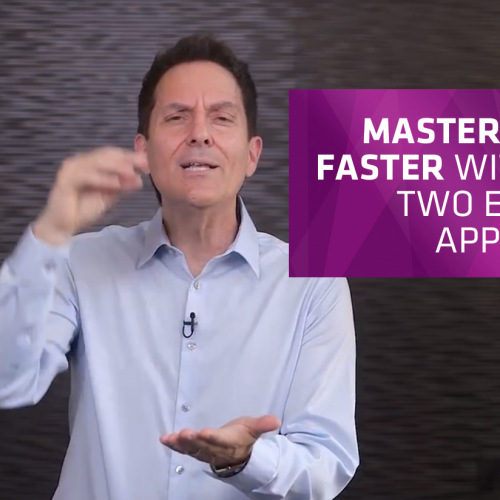To sing alongside the masters and separate yourself from the vast majority of average singers, you need to have one particular feature in your singing toolbox: vibrato! Since my goal is for your singing to sound amazing, I’m going to explain what vibrato is and give you two effective approaches to start using it in your singing today.
Did you like this episode? Then your friends and colleagues will, too!
Share this to make the world sound better, one voice at a time. Your shares also enable me to keep these resources free for you.
Ready for your best life? Unlock your singing voice and get four FREE training videos here.
Subscribe to Roger’s Singing Blog
[xyz-ihs snippet=”Subscribe-to-Blog-SINGING”]
Musically speaking, vibrato is a wavelike movement of pitch.
To claim vibrato for yourself, try:
- The “Fist Bump” Vibrato Approach
- The “Finger Point” Vibrato Approach
Remember that vibrato can take your voice to the next level and make a great impression on your audience. The techniques might feel a little funny at first but rest assured that I’ve used these exact approaches to help Grammy-winning singers create their own vibrato. By following along with this lesson, you’re following in their footsteps and there’s no reason why you can’t have vibrato, as well!
[icon color=”Accent-Color” size=”large” image=”fa-microphone”]
TRANSCRIPT
Hi, I’m Roger Love, celebrity voice coach and top-selling author. I’m working to make the world a better place, one singing voice at a time, starting with yours!
To sing alongside the masters and separate yourself from the vast majority of average singers, you need to have one particular feature in your singing toolbox: vibrato!
But what if you don’t want to be an opera star? Can you pass on this lesson? Only if you’re ready to also pass on your bright future in singing! Vibrato plays a critical role in nearly every musical genre. Beyoncé’s got it. Adele’s a total master of it. Even rock singers use on vibrato to give fullness to their edgy sound.
In case you’ve given up on mastering this special method, please reconsider. You can do it! Nobody is born with vibrato. It’s not an elite DNA strand that you either have or spend your life hoping for. You just have to learn how to do it.
To give you even more motivation to learn vibrato, I’ll share with you my belief that vibrato is so powerful it can be one of the biggest differences between an average and an awesome singing voice. Since my goal is for your singing to sound amazing, I’m going to explain what vibrato is and give you two effective approaches to start using it in your singing today.
Let’s start with some background.
When you listen to a singer hold out a note, there are two basic ways to perform that elongated note. The first way is a simple sustain which I call the Plain Jane Sustain. You just hold it out, like this: [demonstrates] “I CAAAAAAN.”
The second way is to add a little “wiggle,” known as vibrato, like this: [demonstrates] “I CAAAAAN.”
Musically speaking, vibrato is a wavelike movement of pitch. Some amateurs think vibrato is just hitting one note and shaking it like this [demonstrates]. Actually, proper vibrato singing goes a little above and a little below the pitch, like this [demonstrates]. The perfect vibrato speed, according to what most ears prefer, is supposed to be about six oscillations per second, like this [demonstrates].
Now that we’re clear on what vibrato is, you’re probably remembering a lot of your favorite singers and the moments when you’ve heard them use vibrato in action. So you should know that just like our voices, vibrato can sound different depending on the singer. Some singers have a fast vibrato like Madonna. [Demonstrates, “Holiday”] Some have a slow vibrato like Bette Midler. [Demonstrates, “Did I ever tell you you’re my hero?”]
While vibrato can sound different for everyone, the extreme versions are not ideal. For example, when the vibrato is too fast, it can give the impression that you’re nervous and shaky or that you have a goat-like quality to your singing. When it’s too slow, the vibrato can sound like you’re old or tired. Again, the ideal vibrato pace to aim for is about six oscillations per second.
There are stylistic ways to use vibrato, as well. For example, you can feature it at the beginning [Demonstrates at beginning, LOOOOOOOOVE], middle [Demonstrates at middle, LOOOOOOOOVE], or end [Demonstrates at end, LOOOOOOOOVE] of a note, as you get more sophisticated.
Vibrato is worth learning because it can add a unique richness and warmth to your singing voice. In my experience working with celebrity singers, it’s the fastest way to transform your singing voice from boring to beautiful.
Claiming Vibrato for Yourself
So how do you master it? It’s not by shaking your stomach in and out like this [Demonstrates] or moving your jaw up and down, like this [Demonstrates] while you’re onstage.
Instead, good vibrato starts with great air control. To do that, you need to remember your posture: chest up, shoulders back and down, and abdomen relaxed. That part is especially important because you can’t produce vibrato when you’re clenching your stomach area. You have to relax into it.
Most importantly, practice good diaphragmatic breathing so that you can maintain a steady, controlled delivery of air as you sing vibrato. Inhale through your nose and fill up your abdomen as if you’re trying to inflate a balloon. Then as you deliver the air while you sing, let your abdomen slowly fall back in.
With these foundations in place, you’re ready to start practicing vibrato.
Now I’ve seen a lot of coaches simply rock a vibrato-packed song, then close their mouth, look at their students and say, “Just do that.” But even with a degree in music and almost three decades of teaching vibrato, I’ve never seen a student who was in that situation and nailed a perfect impression on their first try.
The way I see it, getting the voice of your dreams is hard enough without having a coach who just tosses you into the deep end. So instead, I’m going to give you two effective approaches to help you get the feel of vibrato so you become familiar with it and can then produce it yourself. In my experience, if you can recognize the feel of vibrato, you’re a lot closer to being able to actually make it yourself.
I call the first approach the “Fist Bump Vibrato Approach.”
Try this along with me now. [Demonstrating] Take your hand, make a fist, and put it on your abdomen. Now, take the other hand, open it up flat, and rest it on top of your first hand, just like this. Start pushing on the lower hand gently as you sing one sustained note. [Demonstrates method] In doing this, you’re literally just forcing sudden bursts of air to exit the mouth.
While practicing this approach, try to concentrate on how air hits the roof of your mouth. Do you notice the way the airbursts feel? Keep focusing on that.
Now, I know I told you a minute ago that shaking your stomach in and out is not how you sing vibrato. I’m only giving you this technique for the moment so you can experience what vibrato feels like. Once you get that sensation, there is no need to shake your abdomen again.
In the meantime, keep practicing this approach until it feels familiar. At that point, take your hands away and try to produce the same vibrato feeling while singing a sustained note.
Ready for the second approach to kick-start your vibrato?
I call it the “Finger Point Vibrato Approach.” Extend your index finger and shake it like this [demonstrates] as if you’re conducting your own voice. Try to make one oscillation per finger movement, one burst of air per wiggle. Try it with me now. [Demonstrates]
Just like with the “Fist Bump Approach,” I’m not telling you to go up for your big solo, whip out your index finger and conduct your own voice in order to sing with vibrato. Instead, I’m trying to give you multiple ways to feel and learn vibrato besides just mimicking me.
If you keep using the approaches I’ve given you, it’s only a matter of time before you can use vibrato in your own singing. Just don’t forget that like all sophisticated things, vibrato has to be used tastefully.
For example, the same way you can’t wear your tuxedo to work every day, you also can’t add vibrato to every note you sustain or else you’ll appear over-the-top. [Demonstrates] “I LOOOOVE YOOOOU, and YOOOOOOOU, say YOOOOOOOU love me, TOOOOOOO.”
Put another way, packing your songs with vibrato is like putting too much ketchup on your French Fries. At some point, you’re just eating ketchup with a side of fries and that’s not what you ordered. Tasteful use of vibrato is just like that. The full song is the main course. Vibrato is just the extra touch that makes it special.
Keep practicing! Remember that vibrato can take your voice to the next level and make a great impression on your audience. The techniques might feel a little funny at first but rest assured that I’ve used these exact approaches to help Grammy-winning singers create their own vibrato. By following along with this lesson, you’re following in their footsteps and there’s no reason why you can’t have vibrato, as well!
If this sounds like you, a great voice can be your solution. Start your effective, fun and impactful voice coaching right now!
[button color=”accent-color” hover_text_color_override=”#fff” image=”default-arrow” size=”medium” url=”https://rogerlovesing.wpengine.com” text=”RogerLoveSingingAcademy.com” color_override=””]


